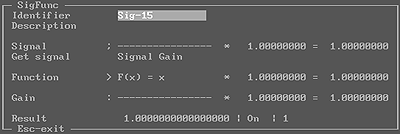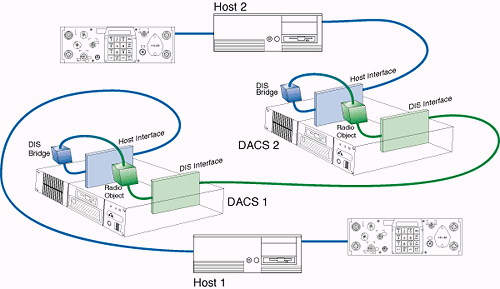

Unfortunately, Model Builder versions 4.04B and prior do not support the TDL feature for radios within the same DACS. The current implementation requires data to come from the Host computer and be passed through the radio object and onto the DIS network. Radios that communicate internal to the DACS do not utilize the DIS interface and therefore would not be able to pass the Tactical data.
The solution to this problem is to combine the radio simulation features of Model Builder and the direct transfer of information between the Host computers. The Host computer is required to monitor the transmit and receive status of the radios involved in the data transfer. The tactical data would be passed directly from Host1 to Host2 when it has indication that one radio is actively transmitting and the other radio is actively receiving. There are objects within Model Builder that can be used to obtain the state (TX or RX) of a radio.
We are assuming that the radios have already been created in the model. From the main model page go to:
Models >> Model1 >> Controls >> Math_Function
and select "Signal_Function".

This object will obtain the status of a given radio. The current "Get signal" field shows "Signal Gain" which is used to show active reception of the referenced radio. This field may be changed to "Active TX" to show active transmission of the referenced radio.
To assign this object to a particular radio highlight the "Signal" field and press ENTER. The Signals list appears. Move the cursor to highlight the desired radio object. Press TAB to input this item into the "Signal" field.
To account for transmit and receive states of a radio make two of these objects with the same radio in the "Signal" field. One object has "Signal Gain" and the other has "Active TX". The output of this object, by default, is 1 when active and 0 when inactive. These values can be sent to the Host computer as status flags for the particular radio.
The "Identifier" and "Description" fields are only text fields used for description.
Now that the status objects have been created we need to send that status to the Host. The Signal_Function object is put into an output object for transmission.
From the main model page go to
Models >> Model1 >> Controls >> Outputs
and select "Out_Int".
Set the "Offset Byte" to correspond to the value selected in the Host ICD. The size value can be set to 1. Obviously the offsets will have to be different for different objects.

To input the Signal_Function highlight the "Output" field and press ENTER. The controls list appears. Highlight the desired Signal_Function object and press TAB to insert. The user will have to create two Out_Int objects, one for TX and one for RX for each radio that is TDL capable.
With the default values, when a radio becomes active a "1" will be sent to the Host.
The above steps outline how to realize a Tactical Data Link for virtual radios within a DACS. It utilizes Model Builder's radio propagation capabilities and the direct transfer of data between host computers. A flag is sent to the Host to denote when the radio chosen for transmission goes into active transmission mode. A second flag is sent to the Host when an in-tune and in-range receives information from the transmitting radio. The Host computer interprets the separate TX and RX flags to mean that a simulated radio link exists and will then transfer the tactical data from one Host computer to the other.
Additionally the Host needs to send a bit to the simulated transmitting radio, toggling the object into and out of the active transmit mode. This is a control variable sent from the Host and should not be used as an indication of active transmission.
There is an obvious flaw to this plan in that with a multi radio system you cannot tell which transmitting radio the receiver is receiving. The solution to this is to dedicate radios for the transmission of tactical data. If the simulator radio needs to be both voice and data capable the MB user could make two sets of virtual radios for each simulator radio. One radio would be set into active transmit when the keyboard or input device for the simulator radio is activated, and the other would transmit only the voice information. With dedicated radios the process of sifting through the active transmit and receive flags is a bit easier.
